oregon
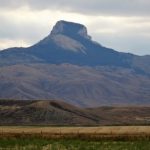
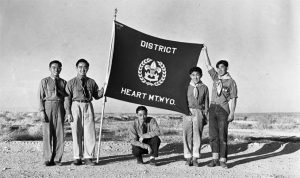 In the middle of a war, the people of a nation become concerned about anyone who might potentially be the enemy, especially if they are living inside the country’s borders. It is really a natural reaction to enemy personnel. After the Japanese attacked Pearl Harbor, the United states became quite concerned about the Japanese immigrants in our country, whether they were here legally or not. Much of the immigration to the United States from Japan began in 1884, when thousands of Japanese arrived in Hawaii to work the sugar cane fields. In the wake of the 1882 Chinese Exclusion Act, which drastically restricted Chinese immigration, Japanese people began arriving and began to prosper and started small businesses or became farmers. Most of them settled along the West Coast, meaning roughly 13,000 people of Japanese descent lived in the Intermountain West prior to World War II. The attack on Pearl Harbor, heightened the level of concern about those people.
In the middle of a war, the people of a nation become concerned about anyone who might potentially be the enemy, especially if they are living inside the country’s borders. It is really a natural reaction to enemy personnel. After the Japanese attacked Pearl Harbor, the United states became quite concerned about the Japanese immigrants in our country, whether they were here legally or not. Much of the immigration to the United States from Japan began in 1884, when thousands of Japanese arrived in Hawaii to work the sugar cane fields. In the wake of the 1882 Chinese Exclusion Act, which drastically restricted Chinese immigration, Japanese people began arriving and began to prosper and started small businesses or became farmers. Most of them settled along the West Coast, meaning roughly 13,000 people of Japanese descent lived in the Intermountain West prior to World War II. The attack on Pearl Harbor, heightened the level of concern about those people.
It was decided that, because their loyalties could not positively be confirmed, the Japanese immigrants needed to be rounded up and put in concentration camps. I suppose this might have seemed similar to what the Germans did to the Jewish people, but the Japanese people were not murdered in the camps, like the Jews were. And so it came to be that the people of Japanese descent from Oregon, Washington and California were incarcerated at the Heart Mountain Relocation Center in Park County, Wyoming, by the executive order of President Franklin Roosevelt. The prisoners were held at the camp from August 12, 1942 to November 10, 1945, which was actually two months after the end of the war with Japan. The camp was populated with 10,000 people at its largest, making it the third largest town in the state at the time.
I have tried to imagine what it must have been like for those Japanese immigrants to be held in the Heart Mountain Relocation Center for as much as 2 years and 3 months. Of course, the illegal immigrants of our time immediately came to my mind, but there is a difference between these people and the illegal immigrants of today. These people were here legally, and most of them had already become citizens. Unfortunately, that did not calm the worried minds of the rest of the people of the United States. Our nation had been attacked, and the attackers looked just like the Japanese immigrants. Precautions had to be taken. I’d like to think that if it were me, in that position, that I would understand why this was happening, but I’m not so sure I would. After all, these people were not criminals. They were hard working Americans, and yet they were for a time…the enemy, or possibly the enemy.
Unfortunately, like many prior immigrant groups, the Japanese faced discrimination. Things aren’t always fair, and people aren’t always treated properly. Starting in the early 20th century, Japanese immigrants, as well as Chinese immigrants, were targeted by Alien Land Laws in western states including Wyoming. These laws prevented the Asian immigrants from buying land. In 1924, the United States Congress passed the Asian Exclusion Act, which all but cut off new immigration from Asia. In response, Japanese Americans formed organizations such as the Japanese American Citizens’ League to help address their shared challenges. Despite 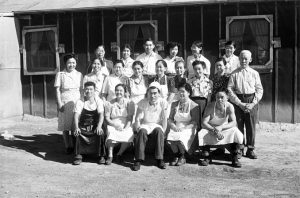 the attempts of Japanese Americans to fit in, some people expressed ongoing skepticism regarding the place of Asians in American society.
the attempts of Japanese Americans to fit in, some people expressed ongoing skepticism regarding the place of Asians in American society.
The Heart Mountain facility consisted of 450 barracks, each containing six apartments, when the first internees arrived on August 12, 1942. The largest apartments were simply single rooms measuring 24 feet by 20 feet. The barracks were covered with tar paper. While each unit was eventually outfitted with a potbellied stove, none had bathrooms. The people all used shared latrines. None of the apartments had kitchens. The residents ate their meals in mess halls. When the people first arrived, a barbed-wire fence to surround the camp was not yet complete. The internees protested the construction of this barrier and caused further work to be delayed. In November 1942, they submitted a petition containing 3,000 signatures to the War Relocation Authority (WRA) Director Dillon Meyer. The fence was completed by December, however, and further emphasized the sense of confinement among the internees. Shortly after the construction of the fence, 32 boys were arrested for sledding in the hills beyond the boundary. In response to the perceived overreaction on the part of the camp administration, Rikio Tomo, a Heart Mountain internee, placed an editorial in the Heart Mountain Sentinel asking for clarification about the internees’ citizenship status and constitutional freedoms. Schools were built at Heart Mountain, including a high school, to accommodate the children. These schools served students from elementary school through high school. Roughly 1500 students attended Heart Mountain High School, which included grades 8-12.
The internees provided most of the labor required to run the Heart Mountain camp, while WRA administrators oversaw its general operations. Wages ranged from $12 per month for unskilled labor to $19 per month for skilled labor, including teachers for the schools and doctors in the camp hospitals. In addition, Heart Mountain internees also worked as manual laborers on farms and ranches in Wyoming and nearby states from Nebraska to Oregon. The WRA administrators encouraged activities emphasizing American civics, such as scouting and adult English classes, as part of what they saw as an Americanization process. Committees composed initially of American-born internees provided much of the day-to-day governance of the camps. While these groups provided some measure of self-determination, they disrupted the generational hierarchy. American-born adults in their 20s and 30s were given a higher political status within the camps than their Japanese-born parents.
In 1943, General George Marshall approved the creation of the Japanese-American combat unit. As a result of the low turnout, the War Department extended the draft to the camps. It was decided that while they were not free to go where they chose, these people were needed to serve their country, so a draft was instituted. After they were drafted into the U.S. Army, soldiers from Heart Mountain occasionally returned to visit their families who were still held there. Somehow that doesn’t seem quite fair to me, and many of the prisoners agreed. They thought they should have been given their constitutional rights back before they were drafted. The organization of draft resistance distinguished Heart Mountain from the other relocation centers. The plan, which was given the endorsement of President Roosevelt, was to create an all-Japanese regiment, consisting of soldiers from a previously existing Hawaiian unit and volunteers from the camps. The response from within the camps fell far short of expectations, partly because of a loyalty questionnaire distributed by the WRA. The WRA form was used to determine eligibility for military service and permanent leave. Many of the questions were considered intrusive by prisoners. Others were not as straightforward as the WRA probably intended. Instead of serving as a neutral tool to determine someone’s suitability for service, the questionnaire further alienated many the men. To me it seems that the WRA was somehow not aware of how racist the entire situation really was. For example, question 27 asked about a person’s willingness to serve in the military. For 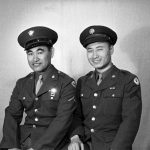
 prisoners who felt service should be contingent upon the restoration of constitutional rights to all Japanese Americans, a simple yes or no answer was insufficient. In each of the camps, the draft became a divisive issue. While some prisoners felt military service was an opportunity to exemplify patriotism, others felt that constitutional rights should be restored before agreeing to mandatory service. I doubt if the situation would have ever really been resolved, except that the war ended.
prisoners who felt service should be contingent upon the restoration of constitutional rights to all Japanese Americans, a simple yes or no answer was insufficient. In each of the camps, the draft became a divisive issue. While some prisoners felt military service was an opportunity to exemplify patriotism, others felt that constitutional rights should be restored before agreeing to mandatory service. I doubt if the situation would have ever really been resolved, except that the war ended.
 Lots of people would love to find a gold mine, stake a claim, and get rich. And if that didn’t work, they would love to stumble on a hidden or long lost treasure. Of course, for most of us that will never happen but that does not mean that those things don’t exist. In 1845, a group of pioneers were traveling by wagon train from Iowa to Oregon. They got as far as the Malheur River about a mile below the present-day Vale, Colorado. They had already traveled about 1,500 miles. They were tired and more than ready to reach their destination, they camped at a spring to rest for the night. The trip had been hard, and they had lost several oxen that had apparently died from poison. When one of the members of the party examined a carcass, his hand was infected and he too died. Tempers flaring within the group of travelers. It was time to bring their journey to a close. They were tough, but this was possibly more than they had bargained for.
Lots of people would love to find a gold mine, stake a claim, and get rich. And if that didn’t work, they would love to stumble on a hidden or long lost treasure. Of course, for most of us that will never happen but that does not mean that those things don’t exist. In 1845, a group of pioneers were traveling by wagon train from Iowa to Oregon. They got as far as the Malheur River about a mile below the present-day Vale, Colorado. They had already traveled about 1,500 miles. They were tired and more than ready to reach their destination, they camped at a spring to rest for the night. The trip had been hard, and they had lost several oxen that had apparently died from poison. When one of the members of the party examined a carcass, his hand was infected and he too died. Tempers flaring within the group of travelers. It was time to bring their journey to a close. They were tough, but this was possibly more than they had bargained for.
Part way through their journey, the wagon train was joined by a man named Stephen Meek. He joined the party somewhere in present-day Montana or Idaho, claimed that he had been to Oregon and knew a shortcut. Along the trail, many of the men had begun to distrust Meek and when the party set out westward from the springs, they split into two groups. One group followed the known route, and the other group went on to Meek’s promised shortcut. The Meek party swung to the south toward the Steen Mountain country. As it turned  out, Meek didn’t really know where he was going and soon the group became angry at him, so he fled the wagon train in fear of his life, after only one week. The fighting among the members of the group caused them to split once again at the headwaters of Willow Creek. Part of the group headed towards Huntington and down the Columbia River, while the rest of the party continued to travel along the Malheur River.
out, Meek didn’t really know where he was going and soon the group became angry at him, so he fled the wagon train in fear of his life, after only one week. The fighting among the members of the group caused them to split once again at the headwaters of Willow Creek. Part of the group headed towards Huntington and down the Columbia River, while the rest of the party continued to travel along the Malheur River.
Along the way, the party met with trouble again as one member was stricken with fever and died, and just a few miles later, several of the oxen were lost. Their journey seemed to be destined to fail. On August 25, 1845, three of the young men soon went out in search of the stock, walking all day and well into the late afternoon before coming to a small stream. After quenching their thirst, they picked up 15 to 20 pebbles in the creek that displayed an unusual color. Finally finding their oxen, they then returned to the train. They showed their stones to the older men in the train, and the “more seasoned” travelers said they were “copper.” When someone asked, “Was there much of it?”, one of the boys replied, “We could have filled one of these blue buckets.” One of the train’s members, Mrs Fisher, kept a single nugget and the train continued its journey, leaving behind the other stones.
Stephen Meek made it to The Dalles and returned to the train with a party of rescuers in order to save them. 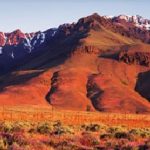 The wagon train finally reached its destination at The Dalles in October 1845. The people began the work of settling into their new home, and forgot about the stones until three years later when gold was discovered in California. Then someone mentioned the 15 to 20 “copper” stones found near the spring on their journey west. They re-examined the stone kept by Mrs Fisher, and soon discovered that it was actually gold. Thus began the search for the mythical or long lost Blue Bucket Mine. Though the location of the gold continues to remain a mystery to this day, it is believed to be at a tributary of the John Day River. I’m sure the people of the wagon train were sorry that they didn’t take the initial find more seriously. I have no idea how big the stones were, but I’m sure they left a sizable amount of money on the prairie that day.
The wagon train finally reached its destination at The Dalles in October 1845. The people began the work of settling into their new home, and forgot about the stones until three years later when gold was discovered in California. Then someone mentioned the 15 to 20 “copper” stones found near the spring on their journey west. They re-examined the stone kept by Mrs Fisher, and soon discovered that it was actually gold. Thus began the search for the mythical or long lost Blue Bucket Mine. Though the location of the gold continues to remain a mystery to this day, it is believed to be at a tributary of the John Day River. I’m sure the people of the wagon train were sorry that they didn’t take the initial find more seriously. I have no idea how big the stones were, but I’m sure they left a sizable amount of money on the prairie that day.
 When my husband’s aunt, Helen Knox passed away on January 11, 2017 at the good old age of 99 years, her passing left her soul mate, Uncle Frank Knox to carry on alone…at least in that the love of his life was not longer with him. Of course, his sons are still here, and his grandchildren, one of whom I have had the great privilege of getting to know over Facebook since her grandmother’s passing. Yesterday morning, it was Frank’s granddaughter, Kate West who passed along the sad news that Uncle Frank had gone to Heaven to join his sweet wife, Helen. My thoughts immediately went back to the times that Frank and Helen came for visits, and what wonderful and interesting people they were. I wanted to write a tribute to Frank about the times I remembered, but then I read about Kate’s memories, and…well, I hope she won’t mind if I take a chapter from her Lifebook for this story. Her memories are so sweet and so thoughtful, that it became very clear to me and to anyone who read her words, that her grandfather was very, very special to her. Nothing I could have said could even begin to compare to the words of his Kate…or to those of her dad, Greg Knox, who told me that the date of Frank’s passing was the same date he and Helen married, just 71 years later. That is a very special day to Frank and Helen.
When my husband’s aunt, Helen Knox passed away on January 11, 2017 at the good old age of 99 years, her passing left her soul mate, Uncle Frank Knox to carry on alone…at least in that the love of his life was not longer with him. Of course, his sons are still here, and his grandchildren, one of whom I have had the great privilege of getting to know over Facebook since her grandmother’s passing. Yesterday morning, it was Frank’s granddaughter, Kate West who passed along the sad news that Uncle Frank had gone to Heaven to join his sweet wife, Helen. My thoughts immediately went back to the times that Frank and Helen came for visits, and what wonderful and interesting people they were. I wanted to write a tribute to Frank about the times I remembered, but then I read about Kate’s memories, and…well, I hope she won’t mind if I take a chapter from her Lifebook for this story. Her memories are so sweet and so thoughtful, that it became very clear to me and to anyone who read her words, that her grandfather was very, very special to her. Nothing I could have said could even begin to compare to the words of his Kate…or to those of her dad, Greg Knox, who told me that the date of Frank’s passing was the same date he and Helen married, just 71 years later. That is a very special day to Frank and Helen.
While Kate is very sad that her grandfather is gone, she is glad that he is with her grandmother again. They  had lived long and happy lives, with 71 of those years lived as husband and wife. When her grandmother passed away, Kate found herself distressed because her grandfather was now without his other half. For Kate, the connection she and her grandpa had was the closest relationship she had with any of her grandparents. Part of the reason is that Frank and Helen lived with Kate’s family for 4 years, from the time Kate was 8 until she was 12. Helen was a little more quiet than her husband was. Frank was always very outgoing, and that made him easy to get to know. The relationship Kate had with her grandfather reminds me of the relationship I had with my Uncle Bill Spencer. Kate’s grandpa, or maybe her dad, taught her the game of cribbage, like my uncle did with me. After that playing cribbage became a ritual. The family used to go camping, and it always seemed to rain, at least one day of the trip. That was all it took for Kate and Frank to get out the cribbage board and pass the time in the friendly rivalry that cribbage always is. Those are the memories that will last Kate for the rest of her life…the memories that will keep her grandfather in her thoughts. She won’t pass a cribbage board without thinking of their games, or hear the rain without thinking of her grandfather. He will always live in her heart, as he will in the hearts of all of those who loved him.
had lived long and happy lives, with 71 of those years lived as husband and wife. When her grandmother passed away, Kate found herself distressed because her grandfather was now without his other half. For Kate, the connection she and her grandpa had was the closest relationship she had with any of her grandparents. Part of the reason is that Frank and Helen lived with Kate’s family for 4 years, from the time Kate was 8 until she was 12. Helen was a little more quiet than her husband was. Frank was always very outgoing, and that made him easy to get to know. The relationship Kate had with her grandfather reminds me of the relationship I had with my Uncle Bill Spencer. Kate’s grandpa, or maybe her dad, taught her the game of cribbage, like my uncle did with me. After that playing cribbage became a ritual. The family used to go camping, and it always seemed to rain, at least one day of the trip. That was all it took for Kate and Frank to get out the cribbage board and pass the time in the friendly rivalry that cribbage always is. Those are the memories that will last Kate for the rest of her life…the memories that will keep her grandfather in her thoughts. She won’t pass a cribbage board without thinking of their games, or hear the rain without thinking of her grandfather. He will always live in her heart, as he will in the hearts of all of those who loved him.
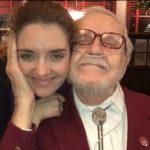
Having moved to Spokane, Kate didn’t get to see her grandfather as often during those last years, and while she feels the regrets that come from a busy life and the difficulty distance brings to staying in touch, I can tell her that for her grandfather, the memories of the fun times with his cribbage partner kept a smile on his face, and she lit up his day with the love that showed on her face for her grandfather. While we may not realize what a huge impact we have of the life of another, they know it. Those around us who care about us, are the bright lights in our lives. That’s what Kate was to her grandfather. Uncle Frank will be greatly missed by all of us, who loved him. We look forward to seeing you again in Heaven, Uncle Frank.

 When you think of Indian arrowheads, you usually think of the Old West or the cowboys and Indians. You think of the battles the Indians had over broken treaties and the influx of settlers into the west. That’s what you think of, but that isn’t what my nephew, Steve Moore thinks of…at least that’s not the only thing he thinks about. For Steve, thoughts of arrowheads bring thoughts of obsidian.
When you think of Indian arrowheads, you usually think of the Old West or the cowboys and Indians. You think of the battles the Indians had over broken treaties and the influx of settlers into the west. That’s what you think of, but that isn’t what my nephew, Steve Moore thinks of…at least that’s not the only thing he thinks about. For Steve, thoughts of arrowheads bring thoughts of obsidian.
You might think that is strange, but Steve has learned the ancient art of flintknap. It all started with his love of wall climbing. He learned to make the hand and foot holds for wall climbing. Then, he started thinking about flintknap. Flintknap is the art of making arrowheads and other weapons from rocks, like obsidian. Steve started  with pieces of broken glass, and later graduated to rocks, and even bone. He and a friend named Scott, made a trip to Oregon and brought back a truck load of obsidian, and Steve taught Scott and another friend, Jay how to flintknap. Steve, made some amazing tools to knap with.
with pieces of broken glass, and later graduated to rocks, and even bone. He and a friend named Scott, made a trip to Oregon and brought back a truck load of obsidian, and Steve taught Scott and another friend, Jay how to flintknap. Steve, made some amazing tools to knap with.
Through the years, Steve got out of the flintknapping hobby for a time…twelve years or so, but has recently picked it up again. Flintknapping is a great hobby to engage in while sitting around the campfire or the fireplace in the evenings. Steve made two arrowheads each weekend these past two weekends. His wife, my niece, Machelle told me that when you are flintknapping, you have to learn how not to bleed. If Steve gets that talent accomplished, I know several people who would like to know the trick to it.
Steve likes obsidian the best, because it creates beautiful shine and color to the arrowheads and other weapons. The rainbow obsidian is one of Steve and Machelle’s favorites because of the beautiful colors it contains. The orange of the pumpkin obsidian is also stunning. When I looked at the pictures that Machelle sent me of Steve’s work, it felt like I was looking at jewels. The arrowheads sparkle and shine, almost like 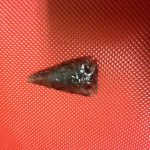
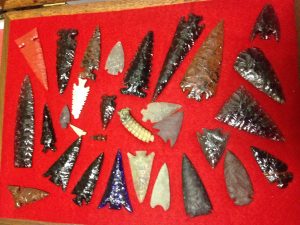 diamonds. I was stunned to find that Steve had such a talent, but then it’s pretty typical of Steve not to blow his own horn. That just isn’t his style, so I guess I’ll just do it for him, because as far as I’m concerned, Steve has an amazing talent. These arrowheads and weapons, while functional if they ever needed ammunition, are so much more than that. They are absolutely beautiful. Today is Steve’s birthday. Happy birthday Steve!! Have a great day!! We love you!!
diamonds. I was stunned to find that Steve had such a talent, but then it’s pretty typical of Steve not to blow his own horn. That just isn’t his style, so I guess I’ll just do it for him, because as far as I’m concerned, Steve has an amazing talent. These arrowheads and weapons, while functional if they ever needed ammunition, are so much more than that. They are absolutely beautiful. Today is Steve’s birthday. Happy birthday Steve!! Have a great day!! We love you!!
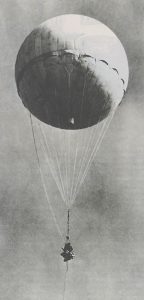 I suppose a true World War II history buff might know about some of the strange war stories there are out there, and I rather thought I was becoming a World War II history buff, but I had never heard of the Japanese Balloon Bombs. I can’t imagine how a nation could send a random bomb over another nation, not knowing where it will land, or who it will kill…but then, the evil we have seen in the 21st century has proven to be very much the same. I guess there really is nothing new under the sun. Where evil exists, horrible things happen. Such was the case with the Japanese Balloon Bombs. The Japanese were an evil nation at that time, and they didn’t care who they hurt. in 1945, a Japanese Balloon Bomb landed in rural Oregon, ad killed six people . As it turns out, these were the only World War II combat casualties within the continental 48 states. Apparently, the accuracy of the balloon bombs left something to be desired…thankfully.
I suppose a true World War II history buff might know about some of the strange war stories there are out there, and I rather thought I was becoming a World War II history buff, but I had never heard of the Japanese Balloon Bombs. I can’t imagine how a nation could send a random bomb over another nation, not knowing where it will land, or who it will kill…but then, the evil we have seen in the 21st century has proven to be very much the same. I guess there really is nothing new under the sun. Where evil exists, horrible things happen. Such was the case with the Japanese Balloon Bombs. The Japanese were an evil nation at that time, and they didn’t care who they hurt. in 1945, a Japanese Balloon Bomb landed in rural Oregon, ad killed six people . As it turns out, these were the only World War II combat casualties within the continental 48 states. Apparently, the accuracy of the balloon bombs left something to be desired…thankfully.
The idea of a balloon bomb was to send in a bomb that was silent. The problem is that balloons are hard to control. They go with the flow of the wind currents, so you don’t know where they will land. Then again, the Japanese were at war with the world, so they really didn’t care where the balloons would land. The six people who were killed by the Fu-Go or fire-balloon bomb, as they were called, were a Sunday School teacher Elyse Mitchell (and her unborn child), her 13 and 14 year old students, Jay Gifford, Edward Engen, Sherman Shoemaker, Dick Patzke, all of whom were killed instantly, when the bomb exploded. Dick Patzke’s sister, Joan was severely burned, and died moments later. The group had stopped for a moment, because Elyse Mitchell was feeling ill, and while her husband, Reverend Archie Mitchell talked with construction workers in the area, the six victims went to investigate a balloon they saw. It would prove to be a fatal mistake. The group had been going on a Saturday afternoon picnic near Klamath Falls, Oregon. They had only walked about 100 yards from the car. One of the road-crew workers, Richard Barnhouse, said “There was a terrible explosion. Twigs flew through the air, pine needles began to fall, dead branches and dust, and dead logs went up.”
Made of rubberized silk or paper, each balloon was about 33 feet in diameter. Barometer-operated valves released hydrogen if the balloon gained too much altitude or dropped sandbags if it flew too low. The balloons were filled with 19,000 cubic feet of hydrogen and the jet stream drew them eastward. They were designed to travel across the Pacific to North America, where they would drop incendiary devices or anti-personnel explosives. I would think the hydrogen alone would make a horrible bomb, but attached to the 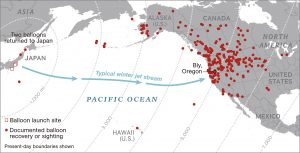 balloon was the actual bomb. The Japanese released an estimated 9,000 fire balloons during the last months of World War II. At least 342 reached the United States, with some drifting as far as Nebraska. Some were shot down. Some caused minor damage when they landed, but no injuries. One hit a power line and blacked out the nuclear-weapons plant at Hanford, Washington. But the only known casualties from the 9,000 balloons…and the only combat deaths from any cause on the U S mainland were the five kids and their Sunday school teacher going to a picnic. What a valiant victory for the Japanese that was.
balloon was the actual bomb. The Japanese released an estimated 9,000 fire balloons during the last months of World War II. At least 342 reached the United States, with some drifting as far as Nebraska. Some were shot down. Some caused minor damage when they landed, but no injuries. One hit a power line and blacked out the nuclear-weapons plant at Hanford, Washington. But the only known casualties from the 9,000 balloons…and the only combat deaths from any cause on the U S mainland were the five kids and their Sunday school teacher going to a picnic. What a valiant victory for the Japanese that was.
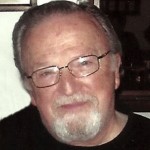 My cousin, Dennis Fredrick and I have been emailing back and fourth for a few weeks now, and it has brought our relationship back to what if used to be, years ago. Time and distance make it difficult for people to stay in touch…even relatives. That is what happened with Denny and me, and now that we have begun to move our relationship back where it should be, I think we are both much happier about it. It’s amazing just how much you miss of someone’s life. The years go by so fast, and before you know it you can feel like you hardly know them anymore, and that is a sad thing to see happen between cousins. The good news is that it’s not too late to change all that, and that is exactly what Denny and I have set out to do.
My cousin, Dennis Fredrick and I have been emailing back and fourth for a few weeks now, and it has brought our relationship back to what if used to be, years ago. Time and distance make it difficult for people to stay in touch…even relatives. That is what happened with Denny and me, and now that we have begun to move our relationship back where it should be, I think we are both much happier about it. It’s amazing just how much you miss of someone’s life. The years go by so fast, and before you know it you can feel like you hardly know them anymore, and that is a sad thing to see happen between cousins. The good news is that it’s not too late to change all that, and that is exactly what Denny and I have set out to do.
Denny recently retired, and that has given him more time to devote to the family history. It’s perfect timing, because I have some pictures that I wanted his opinion on, and he has found some great documents that most of the family had never seen before. Denny’s mom, my Aunt Laura Fredrick has been working on the family history for years, and being the oldest of my grandparents’ children, she had the opportunity to have a copy of her parents’ marriage certificate. With her passing, her years of hard work on the family history were passed on to her son Denny. Now, with Denny’s extra time, and my knowledge of Ancestry.com, it is my hope that we can make some the information available online, as well as to other family members who are online, but maybe not on Ancestry.com.

Of course, the family history is not the only thing that Denny and I have been talking about. There are so many memories to talk about. Our families were so close when they lived in Casper. we loved it when they came over. There was always something fun going on. The conversation was interesting, and there was a closeness between the families. After their move to Oregon, we didn’t get to see them as much. That is the part that both Denny and I feel a loss over. Nevertheless, it’s never too late to catch up on the past, so that’s what Denny and I intend to do…making up for lost time. That is our ultimate goal. It might be a long road, but it will be worth it in the end. Today is Denny’s birthday. Happy birthday Denny!! Have a great day!! We love you!!

 So often, when we have a holiday, people tend to think that it is just another day to have a family dinner and a day off of work. Often, they are celebrating the day for the wrong reason, but not so today. Labor Day is a day for our nation to pay tribute to its workers. No nation can be strong if it has no workers. So, as a show of gratitude, Labor Day was set aside to allow a day of rest for the American worker. When our nation was founded, there was largely nothing here. The native Americans lived in Teepees, so they could be mobile. They needed to follow the buffalo because that was their food supply. But, we had come from nations where there were houses and farms, and ways to get the things we needed.
So often, when we have a holiday, people tend to think that it is just another day to have a family dinner and a day off of work. Often, they are celebrating the day for the wrong reason, but not so today. Labor Day is a day for our nation to pay tribute to its workers. No nation can be strong if it has no workers. So, as a show of gratitude, Labor Day was set aside to allow a day of rest for the American worker. When our nation was founded, there was largely nothing here. The native Americans lived in Teepees, so they could be mobile. They needed to follow the buffalo because that was their food supply. But, we had come from nations where there were houses and farms, and ways to get the things we needed.
Nevertheless, this was a new nation, and it was going to take a lot of hard work to turn it into the great nation it has become. The work was going to be a lot of hard physical labor. We would also need those who would teach our children and others so that they could become doctors, scientists, inventors, and all the other jobs that would be needed to take this from a vast empty land, to a thriving nation that would be able to bring about the dreams that we all came over here to fulfill.
After a time of hard work, and much growth, the nation began to give increasing emphasis to a Labor Day holiday. It was decided that we, as a nation, needed to thank our laborers for all they had done to build this country. The first bill to be introduced was into the New York legislature, but the first state to pass a law was Oregon, on February 21, 1887. Over the course of that year, four more states passed legislation to honor laborers through a Labor Day holiday that was created by legislative enactment. Those states were Colorado, Massachusetts, New Jersey, and New York. By the end of the decade, Connecticut, Nebraska, and Pennsylvania were also listed among the states honoring laborers with a Labor Day holiday. By 1894, 23 other states had adopted the holiday in honor of workers, and on June 28 of that year, Congress passed an act making the first Monday in September of each year a legal holiday in the District of Columbia and the territories.
The first Labor Day holiday was celebrated on Tuesday, September 5, 1882, in New York City, in accordance with the plans of the Central Labor Union. The day began with a parade and continued on with lots of festivities. The Central Labor Union held its second Labor Day holiday just a year later, on September 5, 1883. That was rather odd, considering the fact that the holiday didn’t become official until 1887, and then it wasn’t in New York City. Later, like many holidays, it began to make less sense to keep the holiday on the fifth, and so the first Monday in September was chosen to be the permanent time to celebrate it. That makes sense when you think about it. If you are going to celebrate the laborers, give them a three day weekend. After all, that is 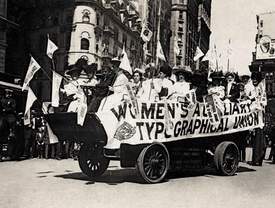
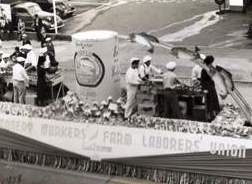 cause for celebration for most laborers. Of course, as we all know, the holiday doesn’t give every worker the day off. That would be almost impossible for all the obvious reasons. Nevertheless, as Labor Day arrives, I hope that each and every worker knows that whether they get the day off or not, this grateful nation has set aside this day to celebrate them, and to thank them for making this nation great. Happy Labor Day to workers everywhere!!
cause for celebration for most laborers. Of course, as we all know, the holiday doesn’t give every worker the day off. That would be almost impossible for all the obvious reasons. Nevertheless, as Labor Day arrives, I hope that each and every worker knows that whether they get the day off or not, this grateful nation has set aside this day to celebrate them, and to thank them for making this nation great. Happy Labor Day to workers everywhere!!
 This year has been unique in a horrible sort of way. We are used to California having fires every year when the Santa Ana Winds kick in, bringing scorching heat that dries out the vegetation, making it vulnerable to the smallest spark. Once the fire starts, they are difficult to contain because of the same winds that started the problem in the first place. We hear of these fires every year…sadly it can seem almost routine…even though it shouldn’t. This year is different, however. This year the whole western coast seems to be on fire. The Redwoods are in danger. Washington, Idaho, and Oregon are also going up in smoke.
This year has been unique in a horrible sort of way. We are used to California having fires every year when the Santa Ana Winds kick in, bringing scorching heat that dries out the vegetation, making it vulnerable to the smallest spark. Once the fire starts, they are difficult to contain because of the same winds that started the problem in the first place. We hear of these fires every year…sadly it can seem almost routine…even though it shouldn’t. This year is different, however. This year the whole western coast seems to be on fire. The Redwoods are in danger. Washington, Idaho, and Oregon are also going up in smoke.
The Pacific Northwest has always been the rainforest of the United States, receiving rain approximately 155 days a year. Since Wyoming gets snow much more often than rain, and in recent years, we haven’t received as much of that as we used to, suffice it to say that we don’t even come close to the amount of rain the Pacific Northwest normally gets. This year however, has found the Pacific Northwest oddly void of rainfall. Wyoming, by a stark contrast, has had a very rainy summer. As someone who doesn’t like days 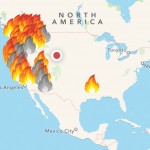 and days of dreary rainfall, that has been a little much for me, but then when I look at the west with its fires, and the rest of the United States largely void of fires, I have to be thankful for the rain. It seems that the only place that is getting very little rain is the west coast.
and days of dreary rainfall, that has been a little much for me, but then when I look at the west with its fires, and the rest of the United States largely void of fires, I have to be thankful for the rain. It seems that the only place that is getting very little rain is the west coast.
I have looked at fire maps many times over the years, but I don’t ever recall the maps having such a lopsided look to them. Nevertheless, that is the look of the current fire map. There is only one significant fire that is not in the west. Our skies are filled with smoke that has rolled in from the west. The mountain is pale behind a curtain of smoky haze, and everything smells burnt…and I’m not even near a fire. I cannot begin to imagine how bad the smoke and the smells are in the thick of the fires. Town after town is being evacuated. Homes, hopes, and dreams are being lost…not to mention lives. It just tears at my heart to think of the devastation to some of the most beautiful rainforest areas of our nation. Places like the Redwoods really could be gone forever, and I can’t begin to imagine how long it will take to bring back the beautiful, moss and fern filled areas of the 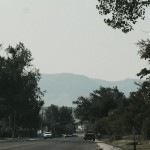 rainforest.
rainforest.
With family and friends all along the west coast, I have been in constant prayer for protection for them, and especially for rain with no lightning. There are some years when fires are so bad, that people can’t wait for summer to end, hoping that the cooler weather will slow down the devastation. I have a feeling that the only thing that will do that will be winter snow or rain, so for their sake, I will agree with their prayers. We have had bad fire years here too, but it never seemed to get quite as bad as it has on the west coast this year. Fires anywhere are awful, but when they are in an area known for it rain, it is simply shocking.
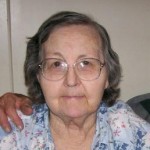
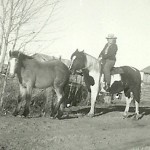 I don’t know if it was because Bob and I had been on vacation or what exactly, but when we went to visit my mother-in-law, Joann Schulenberg, she decided that she had been on vacation too. Her travels took her to San Francisco and to Oregon before finally arriving in Butte, Montana. I don’t know why she chose these particular destinations for her travels, but it is my guess that she thought she had traveled, because we told her that we had been in the Black Hills this past week. When my father-in-law, Walt Schulenberg retired, they did a bit of traveling. They liked to winter in Yuma, Arizona, and then drive to Winnemucca, Nevada to visit her sister Linda Cole and her husband, Bobby. Then, they would drive up the coast to Klamath Falls, Oregon to visit his sister, Esther Hein and her significant other, Keith Leistikaw. I suppose they would have very likely driven through Butte, Montana on their way to Forsyth, Montana to visit family in that area.
I don’t know if it was because Bob and I had been on vacation or what exactly, but when we went to visit my mother-in-law, Joann Schulenberg, she decided that she had been on vacation too. Her travels took her to San Francisco and to Oregon before finally arriving in Butte, Montana. I don’t know why she chose these particular destinations for her travels, but it is my guess that she thought she had traveled, because we told her that we had been in the Black Hills this past week. When my father-in-law, Walt Schulenberg retired, they did a bit of traveling. They liked to winter in Yuma, Arizona, and then drive to Winnemucca, Nevada to visit her sister Linda Cole and her husband, Bobby. Then, they would drive up the coast to Klamath Falls, Oregon to visit his sister, Esther Hein and her significant other, Keith Leistikaw. I suppose they would have very likely driven through Butte, Montana on their way to Forsyth, Montana to visit family in that area.
It’s hard to say for sure what things trigger my mother-in-law’s past memories to come back to her so vividly, when at other times, she doesn’t really recall them much at all. I suppose it is just the way Alzheimer’s Disease works. Sometimes the memories are there and pretty clear, and other times they are just gone. For that reason, you enjoy the memories when she has them. It is always a surprise. Unexpected, and yet always fun. When the memories come, they come with clarity, so I get a glimpse into what her life was like at that time. It’s also at times like these, that I’m thankful for the research I’ve put into her life for the different stories I have written about her, because that has enabled me to converse with her on things she remembers too.
As our time with her went on, she noticed that the clouds had begun to roll in a bit, because there was a chance of rain. But since she didn’t know what month we are in, she said it looked like it might snow. We all told her that since it was the middle of July, it most likely was not going to snow. She was not convinced, however, because as she put it, “When I was out riding my horse earlier, it was snowing.” She said it in such a 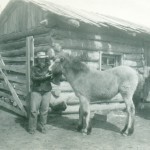
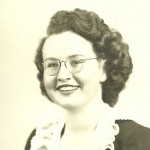 matter of fact way, that I knew she would not be convinced otherwise, so I changed the subject to her horses. We talked of Molly and Pie Face…her colt, of Danny and Twinkles, and of course, Bing. For her, it was like just yesterday that she last saw her beloved horses, because like her mom and dad, Nettie and Bob Knox…who passed in the 1980s, her husband, Walt…who passed in 2013, and her daughter, Marlyce Schulenberg…who passed in 1989, her horses are not gone. They are just at home, outside, or in the corral. They live right there, in her world, and there they will remain for as long as she lives.
matter of fact way, that I knew she would not be convinced otherwise, so I changed the subject to her horses. We talked of Molly and Pie Face…her colt, of Danny and Twinkles, and of course, Bing. For her, it was like just yesterday that she last saw her beloved horses, because like her mom and dad, Nettie and Bob Knox…who passed in the 1980s, her husband, Walt…who passed in 2013, and her daughter, Marlyce Schulenberg…who passed in 1989, her horses are not gone. They are just at home, outside, or in the corral. They live right there, in her world, and there they will remain for as long as she lives.
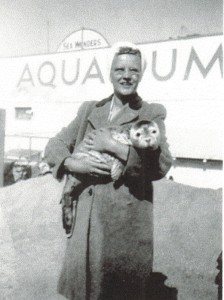 Back in 1946, my Aunt Doris and Uncle Bill decided that they were tired of the bitter cold Wisconsin weather, and that they wanted to try a warmer climate. Uncle Bill had built a travel trailer, and they quit their jobs and headed west. It was a bold move to make, because you never knew what the economy was going to be like in California, or any other part of the country for that matter. The depression was over though, and people were hopeful. I’m quite certain that the warm weather must have felt so good to them, and while there they enjoyed many of the sights. They really didn’t plan to ever go back to Wisconsin.
Back in 1946, my Aunt Doris and Uncle Bill decided that they were tired of the bitter cold Wisconsin weather, and that they wanted to try a warmer climate. Uncle Bill had built a travel trailer, and they quit their jobs and headed west. It was a bold move to make, because you never knew what the economy was going to be like in California, or any other part of the country for that matter. The depression was over though, and people were hopeful. I’m quite certain that the warm weather must have felt so good to them, and while there they enjoyed many of the sights. They really didn’t plan to ever go back to Wisconsin.
So many things can change in such a short time. Parents get older, and their health fades, and before long, you find yourself needed back home. That was the situation they soon found themselves in, and with some regret, they headed back home. Sometimes, that is the way things have to be. They were in a position to help out and others weren’t. It’s is strange, nevertheless, how quickly you can long for home, once you have made up your mind to go. I think it is harder  sometimes on the women to be so far from parents too, because they are a little more sentimental usually.
sometimes on the women to be so far from parents too, because they are a little more sentimental usually.
Still, I have to think that the adventure they had while they were in California and the west coast must have been something they cherished for many years. They got to hold a seal at an aquarium, and stroll along the beach, soaking up the California sun. They saw the Redwood trees, and the rocky coast of Oregon. The memories must have been awesome, because they were free to pick up and go where they chose to each day. Of course, that is never something you can do for very long…at least not until retirement age, but for a while, they got to enjoy that carefree life, and the beauty of the west coast. Today is my Aunt Doris’ 90th birthday. Happy birthday Aunt Doris!! You are still just as beautiful today as you were back then. Have a wonderful day!! We love you!!

